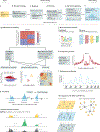Chromatin accessibility profiling methods
- PMID: 38410680
- PMCID: PMC10895463
- DOI: 10.1038/s43586-020-00008-9
Chromatin accessibility profiling methods
Abstract
Chromatin accessibility, or the physical access to chromatinized DNA, is a widely studied characteristic of the eukaryotic genome. As active regulatory DNA elements are generally 'accessible', the genome-wide profiling of chromatin accessibility can be used to identify candidate regulatory genomic regions in a tissue or cell type. Multiple biochemical methods have been developed to profile chromatin accessibility, both in bulk and at the single-cell level. Depending on the method, enzymatic cleavage, transposition or DNA methyltransferases are used, followed by high-throughput sequencing, providing a view of genome-wide chromatin accessibility. In this Primer, we discuss these biochemical methods, as well as bioinformatics tools for analysing and interpreting the generated data, and insights into the key regulators underlying developmental, evolutionary and disease processes. We outline standards for data quality, reproducibility and deposition used by the genomics community. Although chromatin accessibility profiling is invaluable to study gene regulation, alone it provides only a partial view of this complex process. Orthogonal assays facilitate the interpretation of accessible regions with respect to enhancer-promoter proximity, functional transcription factor binding and regulatory function. We envision that technological improvements including single-molecule, multi-omics and spatial methods will bring further insight into the secrets of genome regulation.
Conflict of interest statement
Competing interests All other authors declare no competing interests.
Figures





Similar articles
-
Hydrop enables droplet-based single-cell ATAC-seq and single-cell RNA-seq using dissolvable hydrogel beads.Elife. 2022 Feb 23;11:e73971. doi: 10.7554/eLife.73971. Elife. 2022. PMID: 35195064 Free PMC article.
-
Intrinsic bias estimation for improved analysis of bulk and single-cell chromatin accessibility profiles using SELMA.Nat Commun. 2022 Sep 21;13(1):5533. doi: 10.1038/s41467-022-33194-z. Nat Commun. 2022. PMID: 36130957 Free PMC article.
-
Genomic methods in profiling DNA accessibility and factor localization.Chromosome Res. 2020 Mar;28(1):69-85. doi: 10.1007/s10577-019-09619-9. Epub 2019 Nov 27. Chromosome Res. 2020. PMID: 31776829 Free PMC article.
-
Profiling Chromatin Accessibility at Single-cell Resolution.Genomics Proteomics Bioinformatics. 2021 Apr;19(2):172-190. doi: 10.1016/j.gpb.2020.06.010. Epub 2021 Feb 11. Genomics Proteomics Bioinformatics. 2021. PMID: 33581341 Free PMC article. Review.
-
Chromatin accessibility: a window into the genome.Epigenetics Chromatin. 2014 Nov 20;7(1):33. doi: 10.1186/1756-8935-7-33. eCollection 2014. Epigenetics Chromatin. 2014. PMID: 25473421 Free PMC article. Review.
Cited by
-
Integrative Analysis of ATAC-Seq and RNA-Seq through Machine Learning Identifies 10 Signature Genes for Breast Cancer Intrinsic Subtypes.Biology (Basel). 2024 Oct 7;13(10):799. doi: 10.3390/biology13100799. Biology (Basel). 2024. PMID: 39452108 Free PMC article.
-
Transcriptional bursting dynamics in gene expression.Front Genet. 2024 Sep 13;15:1451461. doi: 10.3389/fgene.2024.1451461. eCollection 2024. Front Genet. 2024. PMID: 39346775 Free PMC article. Review.
-
Image-Based Quantitative Single-Cell Method Showed Increase of Global Chromatin Accessibility in Tumor Compared to Normal Cells.bioRxiv [Preprint]. 2024 Sep 6:2024.09.05.611456. doi: 10.1101/2024.09.05.611456. bioRxiv. 2024. PMID: 39282391 Free PMC article. Preprint.
-
Regression convolutional neural network models implicate peripheral immune regulatory variants in the predisposition to Alzheimer's disease.PLoS Comput Biol. 2024 Aug 26;20(8):e1012356. doi: 10.1371/journal.pcbi.1012356. eCollection 2024 Aug. PLoS Comput Biol. 2024. PMID: 39186798 Free PMC article.
-
Epigenetic Modifications of Hormonal Signaling Pathways in Plant Drought Response and Tolerance for Sustainable Food Security.Int J Mol Sci. 2024 Jul 28;25(15):8229. doi: 10.3390/ijms25158229. Int J Mol Sci. 2024. PMID: 39125799 Free PMC article. Review.
References
-
- Klemm SL, Shipony Z. & Greenleaf WJ Chromatin accessibility and the regulatory epigenome. Nat. Rev. Genet 20, 207–220 (2019). - PubMed
-
- Kornberg RD Chromatin structure: a repeating unit of histones and DNA. Science 184, 868–871 (1974). - PubMed
-
- Mazia D. Enzyme studies on chromosomes. Cold Spring Harb. Symp. Quant. Biol 9, 40–46 (1941).
-
- Luger K, Mäder AW, Richmond RK, Sargent DF & Richmond TJ Crystal structure of the nucleosome core particle at 2.8 Å resolution. Nature 389, 251–260 (1997). - PubMed
-
- Woodcock CL, Safer JP & Stanchfield JE Structural repeating units in chromatin. I. Evidence for their general occurrence. Exp. Cell Res 97, 101–110 (1976). - PubMed
Grants and funding
LinkOut - more resources
Full Text Sources
Other Literature Sources
Research Materials

